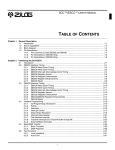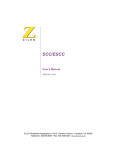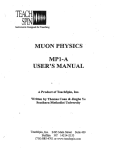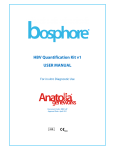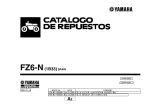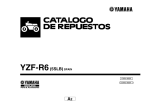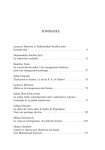Download Using Ohm`s Law to Calibrate a Picoammeter to 0.4 Pico
Transcript
Southern Methodist University SMU Digital Repository Journal of Undergraduate Research Engaged Learning 1-1-2011 Using Ohm's Law to Calibrate a Picoammeter to 0.4 Pico-ampere Precision Joseph Hashem Southern Methodist University, [email protected] Tiankuan Liu Southern Methodist University, [email protected] Zhihua Liang Southern Methodist University, [email protected] Jingbo Ye Southern Methodist University, [email protected] Follow this and additional works at: http://digitalrepository.smu.edu/urajournal_research Part of the Physics Commons Recommended Citation Hashem, Joseph; Liu, Tiankuan; Liang, Zhihua; and Ye, Jingbo, "Using Ohm's Law to Calibrate a Picoammeter to 0.4 Pico-ampere Precision" (2011). American Journal of Undergraduate Research, vol. 10, no. 1. This document is brought to you for free and open access by the Engaged Learning at SMU Digital Repository. It has been accepted for inclusion in Journal of Undergraduate Research by an authorized administrator of SMU Digital Repository. For more information, please contact [email protected], [email protected]. AMERICAN JOURNAL OF UNDERGRADUATE RESEARCH VOL. 10, NO. 1 (2011) Using Ohm’s Law to Calibrate a Picoammeter to 0.4 Pico-ampere Precision Joseph Hashem,a) Tiankuan Liu,b) Zhihua Liang,c) and Jingbo Yed) Department of Physics Southern Methodist University Dallas, Texas 75275 USA Received: April 20, 2010 Accepted: September 14, 2010 ABSTRACT We present an experimental method based on Ohm’s Law to calibrate the Keithley 6485 picoammeter with the calibration error less than 0.4 pico-ampere (pA), which is specified as the highest sensitivity of this instrument. The maximum calibration difference between the measurement current and the calibration current in the picoammeter’s 2 nano-ampere (nA) range is 0.25 pA. This difference is far less than the highest accuracy, 0.4 pA, specified by the instrument. Measurement errors are estimated and discussed. I. INTRODUCTION The purpose of this article is to discuss the nontrivial calibration of the Keithley 6485 picoammeter. In the calibration process we also develop a method to reliably use this instrument in sub-pA measurements. Direct Current (DC) electrical current is measured with an ammeter. A precision digital multimeter with 6½ digits, like the Model 34401A from Agilent Technologies, can measure electrical current to an accuracy of 2 micro-ampere (A) in one year range at a temperature of 23 ± 5°C. These time and temperature conditions apply to the other instruments throughout this paper [1]. The state-of-theart SourceMeter, like the Model 2410 series from Keithley Instruments, Inc., can measure DC current with an accuracy as low as 300 pico-ampere (pA) [2]. However, many applications require higher precision. For example, one commonly uses a picoammeter like the Model 6485 from Keithley Instruments, Inc. to measure the leakage current of a diode. The measurement accuracy in the 2 nA range of this picoammeter can reach down to 0.4 pA [3]. The measurement accuracies of these instruments are listed in Table I in Section II. a) b) c) d) II. CALIBRATION PRINCIPLE We employ Ohm’s Law, R=V/I, to calibrate the picoammeter. With a given resistor, R, and a given voltage, V, the current through the resistor is calculated to be Ical = V/R. By measuring the voltage, V, through the SourceMeter and knowing, precisely, the resistance, R, we can then measure the current, I6485, by the picoammeter and compare Ical with I6485 in order to calibrate the picoammeter. However, the precision of the resistor given by the manufacturer is not precise enough. Note that in order to generate an ultra low current, the resistance must be very large. The ultra high resistance measurement is not trivial. We assume that the resistance of the resistor remains constant throughout the calibration process. With this assumption, we should obtain a straight line in the I-V plot when both the voltage and the current are measured correctly. The resistor we choose is a 100 Giga-ohm (GΩ) resistor of 0.5 W and 2% precision [4]. The exact value of the resistor is measured during the Email: [email protected] Email: [email protected] Email: [email protected] Email: [email protected] 9 AMERICAN JOURNAL OF UNDERGRADUATE RESEARCH VOL. 10, NO. 1 (2011) Figure 1. Schematic (a) and connection block diagram (b) of the picoammeter calibration. calibration. The value of the resistance does not actually affect the measurement as long as one given resistor is used consistently. The highest power consumption in the resistor is approximately 10 micro-Watt with 1000 V voltage over it. This power consumption is very small and is considered to be dissipated quickly to the environment, and hence, does not contribute to any significant temperature increase of the resistor. Our calibration of the picoammeter is done in two steps. The first step of the calibration measures the resistance. We determine the voltage by the SourceMeter and measure the current both by the SourceMeter as I2410 and by the picoammeter as I2nA and I20nA in 2 nA and 20 nA ranges respectively. For practical reasons, only the Keithley 6485 picoammeter’s 2 nA and 20 nA current measurement ranges are used in the calibration. Ranges above 20 nA are relatively easily calibrated and are not discussed in this paper. We then plot the resulting I-V curves. We assume that I2410 is correct above 300 pA, which is the highest instrument accuracy specified in the datasheet.2 We verify that I2nA and I20nA above 300 pA are consistent with I2410 within the instrument accuracy of the Keithley Models 2410 and 6485. The voltage that generates 300 pA through the calibration resistor is 30 V. We then use the voltage readings above 30 V and the current Model Range Accuracy 34401A 2410 6485 6485 2410 10 mA 1 uA 2 nA 20 nA 200 mV ±(I×0.05% + 2 A) ±(I×0.029% + 300 pA) ±(I×0.4% + 0.4 pA) ±(I×0.4% + 1 pA) ±(V×0.012% + 300 V) Table I. Measurement accuracies of Agilent 34401A, Keithley 2410, and Keithley 6485. 10 AMERICAN JOURNAL OF UNDERGRADUATE RESEARCH VOL. 10, NO. 1 (2011) 1.0E-08 2410 20nA 2nA I2410-accuracy I2410+accuracy Current (A) 8.0E-09 6.0E-09 4.0E-09 2.0E-09 0.0E+00 0 200 400 600 800 1000 V2410 (V) Figure 2. The current-voltage curves. readings above 300 pA to fit straight lines for each of the I-V curves. The intersection of each straight line with the I axis is taken to be the system error of each model. The slope of each fitted straight line is the conductance, and the reciprocal of this conductance is the resistance. We then use the weighted average of the three conductance measurements in order to calculate the resistance, R, and use it in the next calibration step. The second step of the picoammeter calibration is to extrapolate each straight line of the I-V curves below the threshold. We attribute any deviations from each straight line to the incorrect measurement of the current by the picoammeter. Hence, we are able to calibrate the picoammeter. The voltage measurement accuracy of Model 2410 is listed in Table I. In order to generate 0.4 pA through the 100 GΩ resistor, the voltage needs to be set at 40 mV. According to the datasheet, the accuracy of this voltage is 304.8 μV. This translates to an uncertainty of 6.08 femto-ampere (fA) in the current calculation, or 1.5% of 0.4 pA. We attribute the uncertainty to one of our calibration errors. Other errors will be discussed in Section IV, along with the calibration results. III. CALIBRATION SETUP A circuit schematic and a connection block diagram are shown in Fig. 1. We use Keithley’s high voltage SourceMeter, Model 2410, with voltage and current read back, to provide the voltage up to 1000.00 V. An ultra high resistance, high voltage, precision, and thick film resistor, RX-1M1009GE from Ohmite Manufacturing Company, is housed inside an aluminum project box. The picoammeter, Keithley 6485, and the high voltage Keithley 2410 SourceMeter, are connected through coaxial cables with BNC connectors. The aluminum project box and the coaxial cables provide shielding against electromagnetic noise throughout the entire system. This is crucial in current measurements within pA range or below. Voltage from 2 mV to 1000 V is set and measured by Keithley 2410. The current 11 AMERICAN JOURNAL OF UNDERGRADUATE RESEARCH VOL. 10, NO. 1 (2011) 1.0E-10 |I20nA-I2nA| (A) 1.0E-11 1.0E-12 1.0E-13 1.0E-14 |I20nA-I2nA| Accuracy 1.0E-15 0 50 100 150 200 Voltage (V) Figure 3. (|I20nA-I2nA|) and I 20nA 2 I 2nA 2 is measured by Keithley 2410 in 1 μA range and Keithley 6485 in 2 nA and 20 nA ranges. Below 200 V, the current is measured by Keithley 2410 and Keithley 6485 in 2 nA and 20 nA ranges. Above 200 V, the current is measured only by Keithley 6485 in 20 nA range and Keithley 2410. In order to acquire data from the picoammeter and the SourceMeter, a National Instruments LabVIEW program was constructed. The LabVIEW program automatically incremented the supply voltage, and read out the voltage and currents from both the SourceMeter and the picoammeter. At each set voltage, the voltage and current were measured 100 times. The averaged current and the standard deviation for each set of 100 current measurements are calculated in the same LabVIEW program. The standard deviation is used as the measurement error in the linear fitting. IV. . average value. The lines in Fig. 2 are the current uncertainty range set by the SourceMeter, i.e., I2410 + ΔI2410 and I2410 ΔI2410, where ΔI2410 is the measurement accuracy of the SourceMeter. As can be seen in Fig. 2, the current measurements of the picoammeter in 20 nA and 2 nA ranges all fall within the SourceMeter uncertainty range. This indicates that the picoammeter and the SourceMeter have consistent current measurement within their accuracy specification. Shown in Fig. 3 is the current difference measured by the picoammeter in 2 nA and 20 nA ranges, (|I20nA - I2nA|), and the square root of the sum of the squares (RSS) of the accuracies in these two ranges, I 20nA 2 I 2nA 2 , where ΔI20nA and ΔI2nA are the accuracies of the picoammeter in these two ranges. The current difference is far less than the sum of the accuracies in these two ranges, indicating that the current measurements of the picoammeter in the two ranges are consistent with each other in their accuracy specification. As discussed in Section II, because we assume that the CALIBRATION RESULTS I-V curves above 30 V are shown in Fig. 2. Each point shown in Fig. 2 is the 12 AMERICAN JOURNAL OF UNDERGRADUATE RESEARCH VOL. 10, NO. 1 (2011) 8.0E-12 2410 6.0E-12 2nA 20nA Redisuals (A) 4.0E-12 2.0E-12 0.0E+00 -2.0E-12 0 200 400 600 800 1000 -4.0E-12 -6.0E-12 -8.0E-12 V2410 (V) Figure 4. The fitting residuals of I-V curves. SourceMeter measures the current correctly, we believe that the current measurements above 30 V in 2 nA and 20 nA ranges by the picoammeter are also correct. Once we verified that the picoammeter current measurements over 30 V are correct in 2 nA and 20 nA ranges, we perform the curve fitting. The fitting process is to minimize the square of the sum of I k YVk I 0 2 2 2 2 k 1 I k Y Vk The slope of the fitting straight line is the conductance, which is the reciprocal of the resistance. The comparison of the fitted conductance values is shown in Fig. 5. The distance between conductance values is within two times of the standard deviation. Since there is only one resistor, three conductance values are averaged based on their errors in order to calculate the average conductance Y, as indicated in Eqs. (1) and (2): N residuals, i.e., min . Y2410 Y2 nA Y20 nA 2 2 Y2410 Y2 nA Y20nA 2 , Y 1 1 1 2 2 Y2410 Y2 nA Y20nA 2 Note that both the current and voltage values have measurement errors; therefore, this is not a normal least square linear curve fitting. Our goal, however, is to fit a straight line. The fitting is done by ROOT [5]. The fitting residuals, ( I YV I 0 ), are shown in (1) Fig. 4. The fitting results are listed in Table II. The intersection I0 is the system error. Comparing I0 in Table I and measurement accuracies in Table II, we conclude that system error, I0, is within the accuracy specified for each instrument. Y 1 Y2410 2 1 . 1 1 Y2nA 2 Y20nA 2 (2) 13 AMERICAN JOURNAL OF UNDERGRADUATE RESEARCH VOL. 10, NO. 1 (2011) 1.0114E-11 Conductance (S) 1.0109E-11 1.0104E-11 1.0099E-11 1.0094E-11 2410 2nA 20nA average Figure 5. The comparison of the fitting conductance. The resistance, R, is calculated by the equation R = 1/Y = (989706.3 ± 8.2) 105 Ω. This is within the specification of the resistor. Once we obtain the resistance, we extrapolated each straight line and calculated the calibration current Ical = YV+I0. The errors, |I – Ical|, are shown in Fig. 6 and compared with the accuracy. As seen in Fig. SourceMeter PA 2 nA PA 20 nA Average 6, the difference between the measurement current and the calibration current are within the accuracy specification, indicating that the current measurements in these two ranges are correct. The maximum calibration error is 0.25 pA in 2 nA range, far less than the highest accuracy, 0.4 pA, specified in Table I. Y (S) I0 (A) (10104.0 ±5.8)10-15 (101028.7 ±7.3)10-16 (1010402.1 ±8.4)10-17 (1010400.8 ±8.3)10-17 -(78.5 ±3.1)10-12 -(5.9 ±8.8)10-14 -(45.7 ±3.6)10-14 N/A Table II. Curve fitting results. 14 AMERICAN JOURNAL OF UNDERGRADUATE RESEARCH VOL. 10, NO. 1 (2011) 1.0E-11 |I2nA-Ical| (A) 1.0E-12 1.0E-13 1.0E-14 |I2nA-Ical| accuracy 1.0E-15 0.0E+00 5.0E-10 1.0E-09 1.5E-09 2.0E-09 Ical (A) 1.0E-10 |I20nA-Ical| (A) 1.0E-11 1.0E-12 1.0E-13 1.0E-14 |I20nA-Ical| accuracy 1.0E-15 0.0E+00 5.0E-09 1.0E-08 Ical (A) Figure 6. |I – Ical| and the accuracy (top: 2 nA range and bottom: 20 nA range). V. CONCLUSION the difference between the measurement current and the calibration current are within the accuracy specification. The maximum calibration difference between measurement current and the calibration current in 2 nA range is far less than the highest accuracy specified. We present a method based on Ohm’s Law to calibrate the Keithley 6485 picoammeter with the calibration error less than 0.4 pico-ampere (pA), which is specified as the highest sensitivity of this instrument. The calibration results show that 15 AMERICAN JOURNAL OF UNDERGRADUATE RESEARCH VOL. 10, NO. 1 (2011) 3. Model 6485 Picoammeter User’s Manual, 1st ed., Keithley Instruments, Inc., Cleveland, OH, 2003. 4. RX-1M Hi-Meg Datasheet, Ohmite Manufacturing Co., Rolling Meadows, IL, 2006. 5. ROOT - An Object Oriented Data Analysis Framework, Rene Brun and Fons Rademakers, Proceedings AIHENP'96 Workshop, Lausanne, Sep. 1996, Nucl. Inst. & Meth. in Phys. Res. A 389 (1997) 81-86. See also http://root.cern.ch/. ACKNOWLEDGMENTS This work is supported by Southern Methodist University and the Hamilton Scholarship. The authors would like to thank Dr. Datao Gong for his help in constructive discussions and technical help in fitting some of the curves using ROOT [5]. REFERENCES 1. Agilent 34401A Multimeter Data Sheet, Agilent Technologies, Inc., Santa Clara, CA, 2007. 2. Model 2410 1100V SourceMeter Service Manual, 2nd ed., Keithley Instruments, Inc., Cleveland, OH, 1998. www.uni.edu/ajur A century of molding scholars into leaders At SMU, we believe that scholars are taught, and leaders are mentored. We have a 100-year history of graduating scholars who know how to lead, and our recent ranking among the nation's best colleges shows that with drive and experience, our graduates can count on becoming prized assets in their professions. Our class sizes are small, with an average faculty-to-student ratio of 12 to 1. And our undergraduate professors are world-renowned scholars and researchers who will get to know you and take a personal interest in your success. With more than 100 majors and minors, as well as accelerated 4 + 1 Master's programs in some schools, chances are SMU has an outstanding academic program that will open doors in your field that you may not have even known were there. www.smu.edu/ 16












